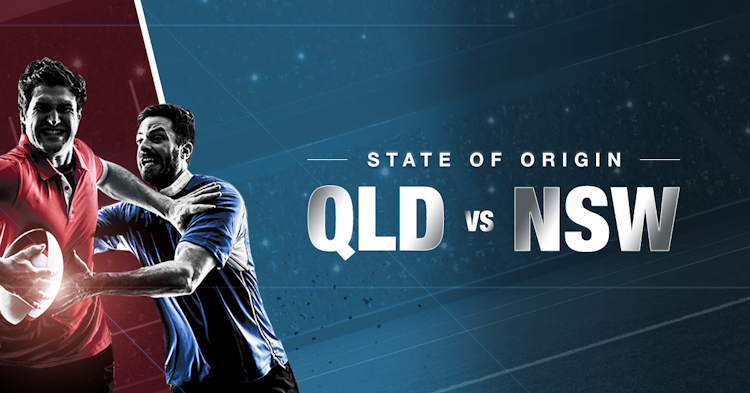State of Origin: How will Game 3 be won or lost
Last updated: Nov 17, 2020, 12:16AM | Published: Nov 16, 2020, 4:29AM
The 2020 rugby league season will end with a State of Origin decider as Brad Fittler and the New South Wales Blues look to make it three series on the bounce over the Queensland Maroons. A turbulent year closes with what many consider the highest of peaks in our game.
Queensland have nothing to lose. They've been written off from the start and simply keeping it close will be enough for some to consider Game 3 a success. Fittler and the Blues, on the other hand, are tasked with changing the tide. They need to complete the job and silence the doubters once and for all.
Wayne Bennett inspired a surprise Queensland performance in Game 1 before New South Wales ran away with the result in Game 2. Now, with 160 minutes of football under their belt, we have a good idea of what has and hasn't worked for the two sides this series.
Queensland Maroons
What has worked: Yardage numbers are the most obvious difference (aside from the scoreboard) between Game 1 and 2. The Maroons fell just 62 running metres short of the Blues in Game 1 but finished up 649 metres in the arrears in Game 2 (1,813m v 1,173m). In short, the Maroons couldn't get up the field often enough to trouble the goal line and pile up points. More importantly, they couldn't get to areas of the field that proved so successful in Game 1.
Queensland's focus on shifting the ball early and targeting the edges paid dividends in Game 1. Often hitting the opposing half (typically Keary) on 3rd or 4th tackle, the Maroons looked to work the ball to the other side of the field via a ball-playing middle. It's where Christian Welch was missed most in Game 2.
This Game 1 set didn't result in a try, but it highlights Queensland's intent with the ball once they worked away from their own goal line.
Felise Kaufusi hits Luke Keary to earn a quick enough play-the-ball before they send the ball to the other side of the field. Welch holds it up long enough to put the defence on their heels and for Kurt Capewell to get on the outside of Clint Gutherson. Back the other way now, Boyd Cordner tries to shut down Queensland's movement but is stood up by Daly Cherry-Evans. That brings Keary in on Kaufusi and leaves Dane Gagai one-on-one with Jack Wighton. Perfect. Gagai bumps off Wighton to send Xavier Coates down the sideline with the lightning-quick Damien Cook the only player capable of saving the day for the Blues.
Queensland later scored two tries running similar sets, both of which we covered last week.
The opportunities rarely came in Game 2, though. Gagai and Capewell, in particular, touched the ball seven fewer times for three fewer runs than a week earlier. Capewell's 162 running metres led the team in Game 2 and remain as proof that Queensland's approach has potential. But for Capewell and Gagai to have the same impact they did in Game 1 this week in Game 3, the Maroons middle and back-three will need to significantly improve and lay a far stronger platform this time around.
What hasn't worked: Queensland couldn't get up the field in Game 2. As effective as hitting the tramlines early in sets proved to be in the opener, the action to look wide on those strong yardage and try-scoring sets came after they had crossed the 40-metre line. That didn't happen often enough last week with Coates, Valentine Holmes and Phillip Sami combining for just 16 kick return metres on the night.
Nathan Cleary put on a clinic with the boot. Andrew Johns called it "the best I’ve seen from a New South Wales half, in all my time watching footy."
Cleary constantly pinned the Maroons in their own end and formed a lethal combination with Josh Addo-Carr who used his blistering speed to apply pressure on the kick-chase. More often than not, Sami had no option but to surrender.
On the other side of the field, Cleary regularly hung the ball up in the air for long enough that Wighton was under Coates' rib cage as he caught the ball.
Queensland repeatedly started their sets on the back foot. None of Dunamis Lui (46m), Josh Papalii (74m), Felise Kaufusi (51m), Jaydn Su'A (58m), Jai Arrow (76m) or Moeaki Fotuaika (24m) managed to crack 100 running metres with only Tino Fa'asuamaleaui (112m) and Lindsay Collins (105m) reaching triple-figures.
Unable to get downhill and into the areas of the field to employ what was a successful game plan in Game 1, Queensland were never able to take control of the match in Game 2.
That needs to change in the decider.
New South Wales Blues
What has worked: While the Blues hold a significant advantage in attack out wide, they're looking their best when playing short and direct around the ruck to start. We talked about their blueprint for success in the build-up to Game 2 by looking back at Damien Cook's try to open the scoring in Game 1.
Much of that blueprint can be seen in Wighton's try shortly after halftime in Game 2. The try stretched the New South Wales lead out to 24-4, going a long way to ending any hopes of a Queensland comeback.
Like Keary did a week earlier, Junior Paulo gets downhill and promotes a quick play-the-ball. Scooting out and weaving away from the markers and hitting the gap between the A and B defenders, Cook takes the attention of both to allow Nathan Cleary to get his head through the line. Back-to-back quick play-the-balls have the Queensland defence retreating. Only just passing the ruck as the ball clears and with their backs to the New South Wales attack, Fotuaika and Su'A are sitting ducks. Cook and Cody Walker have moved the ball out to Wighton before the Queensland pair move off their line. Whatever doubts there are over Wighton in defence, his running game as a centre has always appealed and he beats Gagai enough - just as he did on a separate occasion a week earlier - to stretch out and score.
It's the work around the ruck, short and sharp movements, that makes an on-song Blues team look so good. They don't allow the defence to set, training them into making decisions they will later capitalise on. After repeatedly hitting a flying Angus Crichton in the sets leading up to one particular shift in Game 2, Walker caught Cherry-Evans on his heels. Cherry-Evans had Crichton on his mind which allowed James Tedesco to slip in behind. It took a miraculous try-saver from Gagai to stop the Blues fullback from crossing the line in the corner.
The Blues went searching out wide when trying to chase down the Maroons in Game 1. It's the worst they've looked in the series so far. Straight and direct is the winning formula for the Blues. If they can win the yardage battle and turn field position into points, their biggest weakness is unlikely to be exposed often enough to see the State of Origin shield head north after Game 3.
What hasn't worked:
Brad Fittler looks to crowbar talent into the side and make it work. Clint Gutherson is a fullback, and while others have made the move forward to play well in the centres at Origin level, Gutherson's skills don't translate. Capewell is dominating the matchup through 157 running metres per game along with a try and try assist in Game 1. He has only missed three tackles in the two games. Gutherson, meanwhile, has averaged just 89 metres per game with doughnuts in the attacking stats. He has missed six tackles on the back-rower cum centre.
While Wighton has looked dangerous in attack and his hard-hitting defence was prevalent within the kick-chase in Game 2, he's missed 14 tackles across two games and has become a target for the Queensland attack. Cherry-Evans picked him out to perfection to get the Maroons on the board first last week.
Su'A broke through a flimsy Wighton arms tackle all too easily for a start. After settling back in the middle, Queensland opts to run it on the last and return to Wighton's edge. They know he's an eager defender. With Holmes out the back taking attention and forcing Wighton in, Cherry-Evans throws an excellent ball to Gagai who is already moving away from Wighton's outside shoulder when he receives the ball.
Queensland weren't able to earn many more opportunities to attack their opposing centres, but it's an area they will have again circled in Game 3 should opportunities present themselves.
The pressure is on Wighton and Gutherson to close down what has been New South Wales' leakiest avenue.
How Game 3 will work
As has been the case in Game 1 and 2, the Stats Insider Model has pegged the Blues as significant favourites.
We know better than to rule Queensland out of winning the decider. They failed to turn up last week, but we've seen this movie before. They were a quicker play-the-ball and possible field goal short of causing a monumental upset in Game 3 last year before Tedesco scored the series-clincher.
A lot needs to go right for the Maroons to win. Applying pressure to Cleary's kicking game and working away from their own line effectively is only the beginning. There is no questioning their lack of attacking talent out wide compared to their counterparts. Earning opportunities to score is one thing. Turning them into points is another.
Defensively, there have been moments that the Blues have exposed the Maroons through the middle and it will only take two or three chances early on to start putting this game out of reach.
While questions still remain over Fittler as a coach, his bench rotations and his reluctance to make a change in an obvious problem area in the centres, he's working with the better list. Cleary, in particular, has removed the Mitchell Pearce-like monkey off his back and produced an elite performance when his side needed it most. With Walker and Tedesco in superb form and a pack that is an 80-minute juggernaut in the form of Payne Haas, Daniel Saifiti and Paulo, the Blues can sustain a platform for their superior attack to thrive.
Anything can happen in Origin. Making predictions and releasing them into the world wide web is troll's gold. But as much as some will talk about State of Origin as a variation to regular rugby league won on passion and pride, talent tends to come out on top after three games.
Blues to win in a close one.
Did you enjoy this article? Join our free mailing list to get the best content delivered straight to your inbox, or join the conversation by leaving a comment below or on the Stats Insider Twitter or Facebook page.



